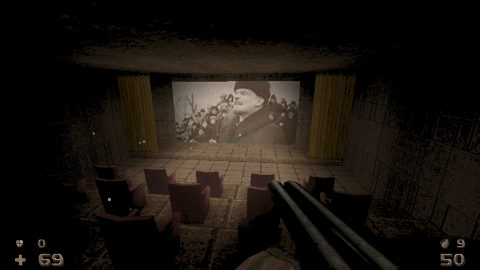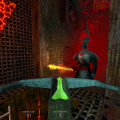Hey! Do you like Quake? Do you like Chasm: The Rift? Do you love the colors brown and gray, but only in the very specific context of Soviet era melancholy? Do you sometimes just listen to the USSR National Anthem but with the bass boosted? Then HROT was made literally for you, hypothetical person. HROT is one of the more interesting entries in the retro shooter wave, but not for the reasons you’d expect. Where it lacks in weapon variety, it more than makes up with a strong sense of character and strong understanding of fundamentals.
HROT was made by one “Spytihněv” (with some help from one Igor Aleksandrowicz), Czech developer who created an original engine in Pascal for this project. That effort really shows in the game, the way the models move and how polygons render never feeling quite like anything from similar games made in Unity or Unreal. There’s a lot of unique touches as well, like how the camera will shift a little in frantic moments to make the fight more immersive, while managing never to go too far and become disorienting.
The real special touch comes from the creator’s background, though. HROT is set during the Cold War in Czechoslovakia (before its dissolve in the 90s), specifically right after the Chernobyl incident. Your character is going around to stop automatic nuclear launches with fail-safe buttons, while fighting the strange enemies that have appeared from the aftermath. None of this is really explained in the game, of course, but the environment tells you a lot itself.
Most levels take place in then contemporary structures, just devoid of any life besides the strange creatures and masked soldiers (some making inhuman noises) you come across. You’ll find abandoned cars, empty stores and buildings dressed in Communist slogans and posters, and a very bare and utility focused architecture. There’s a lot of underground tunnels as well, and even castle levels to shake things up as you go along.
Enemies extend to this greatly. You’ll find flying heads that use the face of Lenin as their face texture. The weird pig creatures named Pedro are named after a chewing gum brand from the area. That weird and vaguely unsettling gas mask horse, Šemík, is based on a horse from Czech mythology. That’s not even getting into the weeds of all the political references, like episode one making you fight the reanimated corpse of former Czech president Klement Gottwald with a horrible inhuman scream and spider legs. He shoots buzz saws at you, as you would expect.
Maybe you’ll find references related to the area, including a Game & Watch knock-off game based on an old Russian cartoon. Health pick-ups will be based on common food stuffs from the region from the time. There’s even a sense of comical whimsy, with the goofy grunts and cries of the bizarre enemies you face down. All of this, mixed with the tense and sparse music by Tibor Knopf and HartWare, makes for a really unique experience, like a slav Quake with a dash of Duke Nukem (even including a melee kick).
The game itself plays like you’d expect for the named influences of Quake and Chasm. You got the fast movement, bunny hopping, and surprisingly, a fairly simple set of weapons. You’ll mostly be using simple bullet weapons, like dual pistols and a submachine gun, with a shotgun and double barrel. The interesting weapon set (which has changed a lot since the early access days) is mostly basic explosives, a mine being the one stand out, and an electric stream gun.
That last one has an interesting ammo replenish mechanic where you can interact with a power box that shocks you but gives some electric ammo, but it’s otherwise a standard load out. That should be a negative, but it actually works pretty well with the often minimal presentation. Every gun feels good to use, has clear moments where they’re most effective, and many enemies use a lot of the same arms to create a bit of synergy with ammo pick ups and push the idea you’re fighting on even footing. Health can be sparse at times, so while it never goes full tactical shooter, you don’t quite feel like an action hero either, but a normal guy trying to protect the country in a bad situation.
What makes the actual gameplay work is that the map design is fantastic. The game’s focus on urban environments should get old, but the actual level layouts keeps every level memorable, knowing how to space out encounters to make the atmosphere stay thick. It makes the campaign feel a bit desperate as you have to keep an eye out for resources, secrets almost being mandatory on harder difficulty levels, but later episodes also like screwing around with you with unexpected set pieces and odd elements. Episode two is particularly good at this, including some horror tinged segments alongside goofy caps to them like a slow build ending with you fighting a random bear. With extra stuff like vent tunnels and swimming mixed in, levels end up having a lot going on.
With the game’s unique cultural flavor, its strong level design, and its thick atmosphere that might even out do Quake, HROT sticks out as something special. You’ll get a great shooter experience, and you might learn a little something about an interesting part of the world in one of its most interesting times – you know, while you kill the reanimated corpse of Klement Gottwald and get rewarded with a beef stroganoff recipe. It’s dumb video game fun with a unique taste, informed by a really interesting historical context. There’s nothing quite like it on the scene today.


